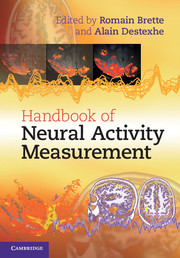Book contents
- Frontmatter
- Contents
- List of contributors
- 1 Introduction
- 2 Electrodes
- 3 Intracellular recording
- 4 Extracellular spikes and CSD
- 5 Local field potentials
- 6 EEG and MEG: forward modeling
- 7 MEG and EEG: source estimation
- 8 Intrinsic signal optical imaging
- 9 Voltage-sensitive dye imaging
- 10 Calcium imaging
- 11 Functional magnetic resonance imaging
- 12 Perspectives
- Plate section
- References
12 - Perspectives
Published online by Cambridge University Press: 05 October 2012
- Frontmatter
- Contents
- List of contributors
- 1 Introduction
- 2 Electrodes
- 3 Intracellular recording
- 4 Extracellular spikes and CSD
- 5 Local field potentials
- 6 EEG and MEG: forward modeling
- 7 MEG and EEG: source estimation
- 8 Intrinsic signal optical imaging
- 9 Voltage-sensitive dye imaging
- 10 Calcium imaging
- 11 Functional magnetic resonance imaging
- 12 Perspectives
- Plate section
- References
Summary
In the nineteenth century, Julius Bernstein invented an ingenious device called the “differential rheotome,” a rotating wheel which could record the time course of action potentials (see Chapter 3). Since then, many sophisticated techniques have been introduced to measure correlates of neural activity: measurements of electricity produced by single neurons (Chapters 3 and 4) or multiple neurons (Chapters 5–7 and 9), measurements based on brain metabolism (Chapters 8 and 11) or on calcium dynamics (Chapter 10). These techniques are always more or less indirect measurements of neural activity, and they have diverse spatial and temporal resolutions, and spatial scales. Each chapter in this book has described the quantitative relationship between neural activity (e.g. membrane potential or synaptic activity) and the measured quantity, as it is currently understood. This effort serves two purposes: to give a better understanding and interpretation of the measurements, and to help enhance existing techniques or develop new ones. To conclude this book, the authors of all the chapters describe ongoing developments in their field, open questions to be addressed, and new emerging techniques.
Extracellular recording
Substrate-integrated microelectrode arrays (MEAs) are planar arrays of microelectrodes used to record electrical activity in neuronal cell cultures or acute brain slices (Taketani and Baudray, 2006; Egert et al., 2010; Gross, 2010). While their history goes back to the 1970s, the rapid development of photolithographic techniques (stimulated by the needs of the computer industry) has now made prefabricated high-density MEA chips a popular research tool.
- Type
- Chapter
- Information
- Handbook of Neural Activity Measurement , pp. 470 - 479Publisher: Cambridge University PressPrint publication year: 2012

